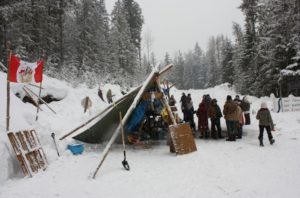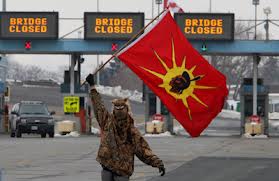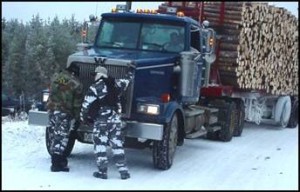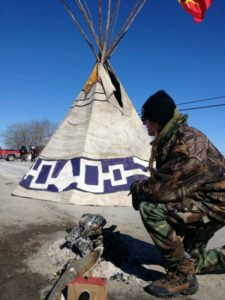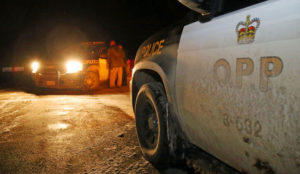(Sinixt blockade camp, March 2014.)
by Greg Nesteroff , Nelson Star, Mar 4, 2014
Two people were taken into custody this morning on a Slocan Valley logging road, less than a day after a judge extended an injunction against the Sinixt First Nation and their supporters.
RCMP Sgt. Darryl Little confirmed two people were arrested without incident for failing to comply with the injunction but said names would not be released until formal charges are laid.
However, Facebook posts have identified one of them as Marilyn James, a prominent member of the Sinixt First Nation. Another post encouraged supporters to attend a hearing at 2 p.m. at the Nelson courthouse, but they had not appeared in court by 3:15. Little said they were being held in Nelson and are expected to be brought over shortly.
Yesterday James suggested she and others would return to the site at daybreak to protect cultural sites in their traditional territory. “I’m a Sinixt woman within Sinixt territory,” she said. “I have to uphold my responsibilities to my society. We’re doing our cultural practices and they’re trying to turn us into criminals.”
Little, who was not present when the arrests were made, said a number of other people were also on site when police arrived but stood aside when asked. He was not sure whether the Crown would proceed with civil or criminal contempt of court charges.
“We will be patrolling the area and monitoring it,” he said. “If the company is blocked we will respond.”
The injunction, which BC Supreme Court Justice Mark McEwan extended until June 30, bars anyone from interfering with Galena Contracting of Nakusp, which has a contract with BC Timber Sales to extend the Perry Ridge forest service road eight kilometers and harvest about 5,000 cubic meters of wood.
(MORE TO COME)
Aboriginal rights a threat to Canada’s resource agenda, documents reveal
(Idle No More protest near Sarnia, Ontario, on January 5, 2012, that blocked border crossing.)
Since 2008, the Ministry of Aboriginal Affairs has run a risk management program to evaluate and respond to “significant risks” to its agenda, including assertions of treaty rights, the rising expectations of aboriginal peoples, and new legal precedents at odds with the government’s policies.
Yearly government reports obtained by the Guardian predict that the failure to manage the risks could result in more “adversarial relations” with aboriginal peoples, “public outcry and negative international attention,” and “economic development projects [being] delayed.”
“There is a risk that the legal landscape can undermine the ability of the department to move forward in its policy agenda,” one Aboriginal Affairs’ report says. “There is a tension between the rights-based agenda of Aboriginal groups and the non-rights based policy approaches” of the federal government.
The Conservative government is planning in the next ten years to attract $650 billion of investment to mining, forestry, gas and oil projects, much of it on or near traditional aboriginal lands.
Critics say the government is determined to evade Supreme Court rulings that recognize aboriginal peoples’ rights to a decision-making role in, even in some cases jurisdiction over, resource development in large areas of the country.
“The Harper government is committed to a policy of extinguishing indigenous peoples’ land rights, instead of a policy of recognition and co-existence,” said Arthur Manuel, chair of the Indigenous Network on Economies and Trade, which has lead an effort to have the economic implications of aboriginal rights identified as a financial risk.
“They are trying to contain the threat that our rights pose to business-as-usual and the expansion of dirty energy projects. But our legal challenges and direct actions are creating economic uncertainty and risk, raising the heat on the government to change its current policies.”
A spokesperson for the Ministry of Aboriginal Affairs declined to answer the Guardian’s questions, but sent a response saying the risk reports are compiled from internal reviews and “targeted interviews with senior management in those areas experiencing significant change.”
“The [corporate risk profile] is designed as an analytical tool for planning and not a public document. A good deal of [its] content would only be understandable to those working for the department as it speaks to the details of the operations of specific programs.”
Last year Canada was swept by the aboriginal-led Idle No More protest movement, building on years of aboriginal struggles against resource projects, the most high-profile of which has targeted Enbridge’s proposed Northern Gateway pipeline that would carry Alberta tar sands to the western coast of British Columbia.
“Native land claims scare the hell out of investors,” an analyst with global risk consultancy firm Eurasia Group has noted, concluding that First Nations opposition and legal standing has dramatically decreased the chances the Enbridge pipeline will be built.
In British Columbia and across the country, aboriginal peoples’ new assertiveness has been backed by successive victories in the courts.
According to a report released in November by Virginia-based First Peoples Worldwide, the risk associated with not respecting aboriginal peoples’ rights over lands and resources is emerging as a new financial bubble for extractive industries.
The report anticipates that as aboriginal peoples become better connected through digital media, win broader public support, and mount campaigns that more effectively impact business profits, failures to uphold aboriginal rights will carry an even higher risk.
The Aboriginal Affairs’ documents describe how a special legal branch helps the Ministry monitor and “mitigate” the risks posed by aboriginal court cases.
The federal government has spent far more fighting aboriginal litigation than any other legal issue – including $106 million in 2013, a sum that has grown over the last several years.
A special envoy appointed in 2013 by the Harper government to address First Nations opposition to energy projects in western Canada recently recommended that the federal government move rapidly to improve consultation and dialogue.
To boost support for its agenda, the government has considered offering bonds to allow First Nations to take equity stakes in resource projects. This is part of a rising trend of provincial governments and companies signing “benefit-sharing” agreements with First Nations to gain access to their lands, while falling short of any kind of recognition of aboriginal rights or jurisdiction.
Since 2007, the government has also turned to increased spying, creating a surveillance program aimed at aboriginal communities deemed “hot spots” because of their involvement in protest and civil disobedience against unwanted extraction on their lands.
Over the last year, the Harper government has cut funding to national, regional and tribal aboriginal organizations that provide legal services and advocate politically on behalf of First Nations, raising cries that it is trying to silence growing dissent.
Grassy Narrows youth promise ‘direct action’ to stop logging inside Whiskey Jack
(Grassy Narrows youth stopping logging truck, 2002.)
By Alan S. Hale, Kenora Daily MIner and News, March 4, 2014
A youth group in Grassy Narrows First Nation has issued a statement saying it will oppose the Whiskey Jack Forestry Plan which is set to take effect this April. The language of the group’s statement seems to suggest the youth may be willing to disrupt any logging operations inside Grassy’s traditional territory, but is not clear on what lengths they would go to in order to do so.
“If the logging begins in our territory, I am certain there will already be planned strategies on our part to bring it to a complete halt,” reads a quote from the statement attributed to Taina Da Silva, a Grassy Narrows Youth organizer.
Some of the members of the youth group are the sons and daughters of the women who originally erected the blockade which has scuttled any notion of logging inside the community’s traditional territory since 2002. Da Silva, for instance, is the daughter of Judy Da Silva, an award-winning aboriginal rights activist, and one of the most ardent opponents of the province’s plans for forestry inside the Whiskey Jack Forest.
Edmond Jack’s mother was one of the founders of the movement which began the Grassy Narrows blockade, and has himself grown up to be an activist who places much importance in protecting his community’s ability to live a traditional existence; something he believes logging operations will put in jeopardy.
Jack said he expects the youth group will take “direct action” if logging does begin inside of their territory, but when asked if this meant the youth group was prepared to intentionally disrupt forestry operations, he was noncommittal.
“Grassy Narrows has a reputation because of the 10-year blockade. And I guess what we’re planning to do isn’t too much different than what they’ve been doing,” said Jack.
“Our main focus is to try to stop the logging because we’re completely against it.”
According to Jack, the goal of the youth group is not political action, but rather to get more of the Grassy Narrows’ young people out and participating in traditional ways of life such as trapping, hunting and fishing inside their territory. And they intend to continue to do those things regardless of whatever other plans the province might have for that land.
“Regardless of what the harvesting schedule is, when springtime comes we’re going to be out on the land and exercising the old ways,” he said.
Jack said he believes that a return to a more traditional way of life is the way to help get people away from the “unhealthy lifestyles” many of the people in his community are living. And to be able to engage in those cultural activities, the land needs to be protected from logging.
When asked if the employment offered to the community from logging might also help improve life in Grassy Narrows, Jack said he doesn’t expect many people in the community would take those jobs because they come at the expense of the land.
Despite the frustration over the province moving ahead with its forestry plan despite a Supreme Court challenge from Grassy Narrows, and the almost immediate rejection of a proposal which would give control of the logging industry in the Whiskey Jack to local First Nations, Jack said he is optimistic that Grassy Narrows will eventually win the issue.
“People in Grassy Narrows don’t have the same opportunities and advantages as many other people, but they do have the opportunity to live in a way where they can actually sustain themselves on the land. I think that if the government is going to come and take that away, it just shows they value money over people.”
Tyendinaga Mohawks begin blockade for missing/murdered women
(Tyendinaga Mohawks have erected a tipi as part of their blockade, March 2, 2014.)
By Krystalline Kraus, Rabble.ca, March 3, 2014
As of Sunday, roughly 70 members and supporters of the Mohawks of Tyendinaga erected a blockade on Shannonville Road, pushing for the Canadian government to host a genuine inquiry into the disappearances and deaths of Indigenous women across Canada — thus stating their dissatisfaction of the Oppal Inquiry.
As of reports from Sunday night, “two large fires are going across the street and vehicles are parked, blocking Shannonville Road.”
The federal government has already insisted that it is willing to commit $25 million to the National Centre for Missing Persons and Unidentified Remains. While this is a start, the mandate is not specific to why First Nations women are at a higher risk of violence due to historical and socio-economic factors.
This blockade should not be a surprise to anyone, since Tyendinaga Mohawk resident Shawn Brant had already warned the federal government — and especially Stephen Harper — that the government had until the end of February 2014 to start a campaign of direct action if an inquiry into murdered and missing Indigenous women was not called.
In his challenge, formed in a letter to government, he states:
“I am writing in regards to a mandate issued from the Mohawk Community of Tyendinaga, dated October 27 2013, requiring your cooperation for the facilitation of a national inquiry into the circumstances of murdered and missing First Nations Women…In a report, published in September 2013 by MaryAnne Pearce and recently obtained by the Royal Canadian Mounted Police (RCMP), some 824 FirstNations women have now been identified as having been murdered or gone missing, with a majority of those cases documented as having occurred in the past 15 years.”
People across Canada rallied in the thousands on February 14, 2014, in support for the end to the violence, death and disappearances.
Brant’s Dear Harper letter continues:
“Your unwillingness to consider this first step at reconciliation is well documented and understood.
It is our opinion that all diplomatic means to convince you of the need for an inquiry have failed. Further, the tears and sadness of the families left behind have not moved you to any position of compassion.
We have therefore resolved that we will take whatever and further actions that are deemed necessary, to compel you to call a National Inquiry into the crisis of Murdered and Missing Aboriginal Women and Girls.”
The direct action on Shannonville Road was technically started on Saturday March 1, 2014, when Ontario Provincial Police shut down Wyman Road, which is east of Shannonville Road, late into Friday afternoon when a handful of demonstrators first lit a bonfire near Highway 401.
More to come.
Tyendinaga Mohawks begin actions for Missing/Murdered Women
(Ontario Provincial Police at the site of Tyendinaga Mohawk protest, Feb 28, 2014.)
By Luke Hendry, The Intelligencer, February 28, 2014 (via Red Power Media)
First Nations protesters on Friday vowed further demonstrations in the week ahead as they called for a federal inquiry into the issue of missing and murdered aboriginal women.
“You’ll see us this week,” said protester Dan Doreen of the Tyendinaga Mohawk Territory.
Asked whether that would include more protests this weekend, he smiled broadly and repeated, “You’ll see us.”
Ontario Provincial Police closed Wyman Road, east of Shannonville, late Friday afternoon as fewer than 10 protesters sat around a bonfire near the intersection of Wyman Road and Highway 401.
“We have closed Wyman Road between Highway 2 and Callaghan Road,” said OPP Sgt. Kristine Rae.
“Highway 401 is still open.
“There’s about six people around a fire on the shoulder of Wyman south of Highway 401,” she said just after 5 p.m.
“Right now it’s very peaceful. They’re not on the road, they’re in the ditch.
“We have had people attempting to talk to them. That’s about all I can say.”
Police later met with the protesters
Heavy OPP presence has been reported along Highway 401, especially at on- and off-ramps.
Police cruisers idled on the shoulder and median of Canada’s busiest highway during the evening.
But the protesters extinguished their fire and left the scene at about 8 p.m., police said.
Asked whether police would close the highway amid protests, Rae replied, “It really depends on the actions of people down there. At this point, no.”
The Wyman closure, meanwhile, was “just a safety precaution,” she said.
Police were seen meeting with protesters.
The protest focuses on the lack of an inquiry into why hundreds of First Nations women have vanished or been killed in the last several decades.
Tyendinaga activist Shawn Brant has been quoted as calling for a federal inquiry into the issue.
In an open letter to Prime Minister Stephen Harper published online Thursday, Brant pledged to take undisclosed action to push for that inquiry.
“It is our opinion that all diplomatic means to convince you of the need for an inquiry have failed,” he wrote in the letter, which appeared on firstperspective.ca, a First Nations news website.
“Further, the tears and sadness of the families left behind have not moved you to any position of compassion,” he continued.
“We have therefore resolved that we will take whatever and further actions that are deemed necessary, to compel you to call a national inquiry into the crisis of murdered and missing aboriginal women and girls,” Brant wrote.
His letter cited a report indicating “some 824 First Nations women have now been identified as having been murdered or gone missing, with a majority of those cases documented as having occurred in the past 15 years.”
Both protesters and police spoke of peaceful protests.
“We’re here to keep the peace,” said one protester. “Anything else is on them (police).”
The group refused an interview request.
“Missing and murdered women. That’s all that has to be said,” Doreen said. “There’s nothing to report here right now.”
Asked whether there would be more protests this weekend, he smiled broadly.
“You’ll see us.”
The OPP issued press releases Thursday and Friday to say officers “respect peaceful, lawful protest” and are “continuing to monitor the area and will be using a measured response that considers the safety of the public, protestors and the police.
“Anyone involved in criminal activity will be held accountable,” it read.
Rae said police were prepared for further protests. She advised travellers to check the OPP eastern region Twitter feed at http://www.twitter.com/opp_er and reports by local media.
http://www.intelligencer.ca/2014/02/28/police-close-wymans-road-east-of-shannonville
http://warriorpublications.wordpress.com/
